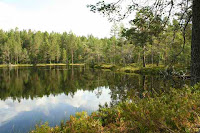 Given the upcoming year 2010, when progress towards the 2010-target is to be assessed, relevant and credible indicators of European biodiversity are of outmost importance. On important aspects of European forest biodiversity the indicators suggested by the European Environment Agency (EEA) fails to provide the needed evaluation.
Given the upcoming year 2010, when progress towards the 2010-target is to be assessed, relevant and credible indicators of European biodiversity are of outmost importance. On important aspects of European forest biodiversity the indicators suggested by the European Environment Agency (EEA) fails to provide the needed evaluation.In a recent report from the EEA (Anon 2007), sets of indicators are presented for European biodiversity aiming at evaluating the 2010-target. Concerning forest biodiversity three indicators are suggested; Ecosystem coverage, Forest growing stocks and Dead wood. Of these only the last has any relevance for the biodiversity trends in European forests.
- Ecosystem coverage of 13 different ecosystem types is suggested and any kind of tree covered area is one of these indicators. The claim is that this indicator "has a high relevance for biodiversity because it indicates the area of available habitats and ecosystems across Europe". This is simply not true. We have seen major ecosystem shifts within European forests through the logging of old-growth natural forests, use of exotic tree species, fertilization, drainage and various types of pollution. A simple measure of tree covered areas masks all these factors having profound negative effects on forest biodiversity.

- For indicator “Forest growing stock” is stated that "Growing stock is an important and well‑accepted proxy for biodiversity". The increase in growing stock seen in several European countries has come as a consequence of intensive forest management including, clear-cutting, thinning, exotic tree species, fertilization, drainage and plant breeding. These activities all have negative consequences for forest biodiversity as they cause loss of natural forest habitats and genetic variation. In no respect does “growing stock” serve as a valid “proxy for biodiversity”
The clear failure to identify relevant indicators of European forest biodiversity is surprising and raises the question behind this failure. I assume that the intentions have been the very best and that something in the process has gone wrong. With due respect to the individual experts taking part in the process, I do note that with a few exceptions the experts are officials from various organizations, authorities and ministries. The limited involvement of scientist is obvious. I cannot evaluate if this is a deliberate choice of the EEA or a lack of interest from the scientific community to participate. For whatever reason, the result is that the SEB 2010 lack relevant and credible indicators on forest biodiversity and hence should not be used to evaluate the 2010-target.

No comments:
Post a Comment